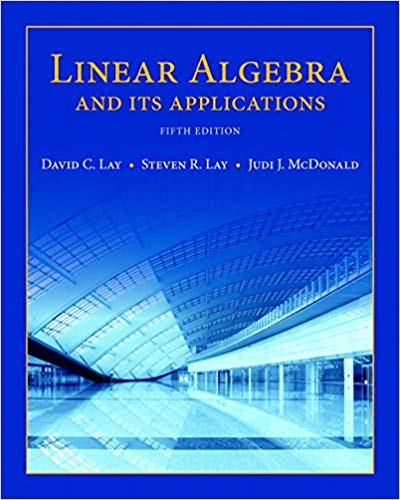
Linear Algebra and Its Applications, 5th Edition
Authors: David C. Lay, Steven R. Lay, Judi J. McDonald
ISBN-13: 978-0321982384
We have solutions for your book!
See our solution for Question 7E from Chapter 1.3 from Lay's Linear Algebra and Its Applications, 5th Edition.
Problem 7E
Chapter:
Problem:
Use the accompanying figure to write each vector listed in Exercises 7 and 8 as a linear combination of u and v. Is every vector in ℝ2 a linear combination of u and v? Vectors
Step-by-Step Solution
Given Information
We are given with a figure with u and v coordinate axis. We have to write each vector as a linear combination of $u$ and $v$. To find the linear combination, we will start from the origin and count the number of steps in each direction to reach required vector.
Step-1: The vector ${\bf{a}}$
To reach the vector ${\bf{a}}$, we move 1 block in u-direction and -2 blocks in v-direction. Therefore,
\[{\bf{a}} = {\bf{u}} - 2{\bf{v}}\]
Step-2: The vector ${\bf{b}}$
To reach the vector ${\bf{b}}$, we move 2 blocks in u-direction and -2 blocks in v-direction. Therefore,
\[{\bf{b}} = {2\bf{u}} - 2{\bf{v}}\]
Step-3: The vector ${\bf{c}}$
To reach the vector ${\bf{c}}$, we move 2 blocks in u-direction and -3.5 blocks in v-direction. Therefore,
\[{\bf{c}} = {2\bf{u}} - 3.5{\bf{v}}\]
Step-4: The vector ${\bf{d}}$
To reach the vector ${\bf{d}}$, we move 3 blocks in u-direction and -4 blocks in v-direction. Therefore,
\[{\bf{d}} = {3\bf{u}} - 4{\bf{v}}\]
We are given with a figure with u and v coordinate axis. We have to write each vector as a linear combination of $u$ and $v$. To find the linear combination, we will start from the origin and count the number of steps in each direction to reach required vector.
Step-1: The vector ${\bf{a}}$
To reach the vector ${\bf{a}}$, we move 1 block in u-direction and -2 blocks in v-direction. Therefore,
\[{\bf{a}} = {\bf{u}} - 2{\bf{v}}\]
Step-2: The vector ${\bf{b}}$
To reach the vector ${\bf{b}}$, we move 2 blocks in u-direction and -2 blocks in v-direction. Therefore,
\[{\bf{b}} = {2\bf{u}} - 2{\bf{v}}\]
Step-3: The vector ${\bf{c}}$
To reach the vector ${\bf{c}}$, we move 2 blocks in u-direction and -3.5 blocks in v-direction. Therefore,
\[{\bf{c}} = {2\bf{u}} - 3.5{\bf{v}}\]
Step-4: The vector ${\bf{d}}$
To reach the vector ${\bf{d}}$, we move 3 blocks in u-direction and -4 blocks in v-direction. Therefore,
\[{\bf{d}} = {3\bf{u}} - 4{\bf{v}}\]